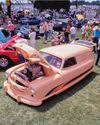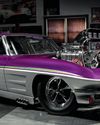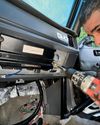
It's safe to say that performance enthusiasts have embraced electronic fuel injection. That's not to say that carburetors can't do the job, but Detroit hasn't rolled a new car off the assembly line with a carburetor in almost 40 years. Since then, we have seen the evolution of EFI systems move from crude to precise in their control of fuel metering and ultimately the air/fuel ratio seen by the spark plug in the cylinders.
The fuel injectors themselves have also evolved. Not only has their physical size diminished enough to allow some creative placement options in the intakes, but manufacturers also offer flow rates that enable us to make amazing amounts of horsepower with just a single injector per cylinder. I fondly remember my early days of playing with fuel injection in the late '90s, when a 42 lb/hr (roughly 440cc/min) injector flow rate was considered "big"-I have more recently tested direct-replacement options for many port-injection applications that deliver over 286 lb/hr (3000cc/min), depending on the pressure being used.
This story is from the February 2024 edition of Hot Rod.
Start your 7-day Magzter GOLD free trial to access thousands of curated premium stories, and 9,000+ magazines and newspapers.
Already a subscriber ? Sign In
This story is from the February 2024 edition of Hot Rod.
Start your 7-day Magzter GOLD free trial to access thousands of curated premium stories, and 9,000+ magazines and newspapers.
Already a subscriber? Sign In

What Is Pro Street?
You know it when you see it.

Pro Street in Pure Vision
Builder Steve Strope weighs in on the Pro Street look and what he would build today.

THE GAS ERA LIVES ON
These vintage race cars chart the evolution of technology in the early days of drag racing.

MOTOR HEAD FOR LIFE
Scott Sullivan is one of the original Pro Street pioneers. He still builds cars today out of a small shop in Dayton, Ohio.

BRINGING BACK PRO STREET!
David Freiburger and Roadkill Garage built a Pro Street Nova.

SWEET ASPIRATIONS
Jerry and Matthew Sweet added an 800ci Pro Stock mountain motor to chase HOT ROD Drag Week's Pro Street NA Record.

Making Bad Decisions Badder
Bradley Gray's 1970 Nova is a Hybrid! It's a streetable Funny Car.

ART PROJECT
This Rad Rides by Troy-built '63 split-window Corvette went from restaurant prop to ripping up the street!

WHERE DO WE GO FROM HERE?
THE PRO STREET ERA PEAKED IN THE '80S. ARE WE IN THE BEGINNING OF A RESURGENCE?

Making Connections
Project T-top Coupe: We install a Terminator X Max for big power.
